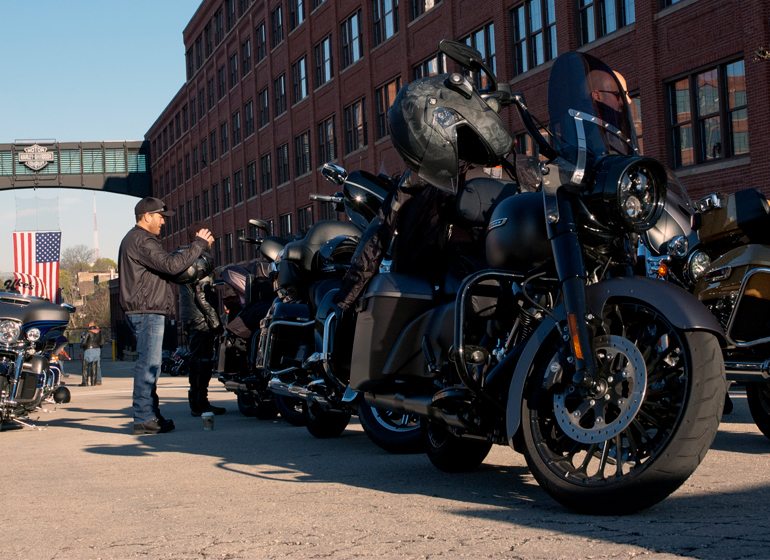Milwaukee-based Harley-Davidson Inc. was already expecting an increase in raw material costs this year, but new tariffs on steel and aluminum announced by President Donald Trump could add another $15 million to $20 million in additional costs, John Olin, Harley chief financial officer said Tuesday.

“That’s going to provide quite a headwind for the company,” Olin said.
He cautioned the figure is an estimate based on what prices have done since the tariffs – 25 percent on steel and 10 percent on aluminum – were announced in February. Olin added that Harley saw a $4.2 million increase in raw material costs in the first quarter that was not the result of tariffs.
When the tariffs were first announced, Harley warned there could be “significant impact” from retaliatory tariffs and said in a statement the measures would drive up costs. Heavyweight motorcycles like Harley’s were among the products the European Union said could be hit with tariffs if Trump goes through with his plans.
Europe was one of the bright spots in Harley’s first quarter results. Retail sales in Europe, Middle East and Africa were up 6.8 percent in the quarter and Olin said new Softail models the company introduced are selling particularly well in Europe.
The international business was up overall with retail sales increasing 0.2 percent. The company had expected sales outside the U.S. to be down slightly, but the strength in EMEA combined with a 7 percent increase in Latin America to offset declines in Asia Pacific and Canada.
The U.S. market was a different story as retail sales declined 12 percent to 29,300 in the quarter. Harley has been battling an increasingly competitive market plus low used motorcycle prices that deter people from buying new products.
Minneapolis-based Polaris Industries Inc., meanwhile, reported its motorcycle segment increased revenue 9 percent to $132 million. The company said retail sales of Indian Motorcycles, the main domestic competitor to Harley, were up low-single digits in North America during the quarter.
Harley’s worldwide shipments of new motorcycles were down 9.7 percent as the company continued to try to limit inventory in the United States. Dealers ended the quarter with 9,100 fewer motorcycles in stock compared to the end of the first quarter in 2017. The decrease comes after an 8,000 unit cut in inventory from 2016 to 2017.
“We’ve significantly tightened things up,” Olin said.
Despite the declines in sales and shipments, Harley’s revenue was up 2.7 percent to $1.54 billion for the quarter. Net income, however, was down by 6.2 percent to $174.8 million, including a $46.8 million charge from the company’s manufacturing optimization plan. The plan includes the closing of the Kansas City assembly facility with work moving to a similar facility in York, Pennsylvania.
Earnings were down from $1.05 to $1.03 per diluted share.
Limiting new inventory is part of Harley’s effort to push used motorcycle prices higher. The company has also introduced a number of new models in an effort to persuade people to buy new. Analysts on the company’s earnings call noted the new products have been well received by dealers, but haven’t translated to improved sales in the U.S., suggesting it might be a problem with marketing.
“The price gaps (between new and used) are so large it does impact our good product and our good marketing,” Olin said, suggesting the company is facing a number of headwinds in the U.S. “We do not believe it is an issue with marketing. We think our marketing is fantastic.”
Matt Levatich, Harley chief executive officer, said the company would be providing an update on its strategy this summer. He said the details are still being finalized but the plan calls for an acceleration of Harley’s growth efforts through 2022.
Harley unveiled a 10-year strategy last year that calls for the launch of 100 new models, creating 2 million new riders in the U.S. and growing its international segment to 50 percent of the business.
Levatich said the company sees that plan “as absolutely on point,” adding this summer’s announcement would be about “very specific action plans to capitalize on global opportunities we see for growth.” The plans include entry into new product space, new market channels and new partnerships and collaborations.
When analysts asked how far from its core products Harley might go, Levatich said the company will be creative but stay true to its brand.
“Just to reassure everyone, we’re being bold, we’re being very open-minded, but we’re being very responsible in acknowledging the strengths that we can leverage and the opportunities we can pursue,” he said.
One area Harley is sure to expand is electric motorcycles. The company’s Project Livewire prototype has led to years of speculation about when it would introduce a production model. In January the company said it would introduce what Levatich called a “Livewire-derivative” model within the next 18 months. Then in March, Harley announced an equity investment in California-based Alta Motors.
Levatich said the investment is about building out a portfolio of electric motorcycle products beyond the Livewire-related model and said he would talk specifically about plans this summer.
“We couldn’t be more excited about electric technology represents,” he said. “We see electric as playing a key role in opening up new spaces and opportunities.”


